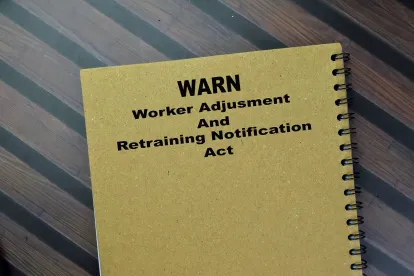On June 21, 2023, the New York State Department of Labor (NYSDOL) published updated regulations concerning the New York State Worker Adjustment and Retraining Notification Act (NYS WARN Act).
Quick Hits
-
The New York State Department of Labor published updated NYS WARN Act regulations that provide additional clarification for employers anticipating plant closings, mass layoffs, relocations, or reductions in work hours.
-
The updated regulations address subjects such as remote employees, the transfer of employees as a condition of a purchase agreement, and employer notices to additional entities.
-
The updated regulations took effect on June 21, 2023.
Overview of NYS WARN ACT
The NYS WARN Act, which provides stricter requirements than the federal Worker Adjustment and Retraining Notification Act of 1988, requires businesses with fifty or more full-time employees to provide ninety days’ notice of employment losses to affected employees and certain government entities or officials. Under the statute, an “employment loss” is defined as “(a) an employment termination, other than a discharge for cause, voluntary departure, or retirement; (b) a mass layoff exceeding six months; [or] (c) a reduction in hours of work of more than fifty percent during each month of any consecutive six-month period.” The statute further defines a “mass layoff” as “a reduction in force” which:
-
-
is not the result of a plant closing; and
-
results in an employment loss at a single site of employment during any thirty-day period for:
-
-
-
-
at least thirty-three percent of the employees (excluding part-time employees); and
-
at least twenty-five employees (excluding part-time employees); or
-
at least two hundred fifty employees (excluding part-time employees).
-
-
Key Provisions of the Updated Regulations
The updated regulations, which took effect immediately, reflect statutory changes made to the NYS WARN Act in 2021, and provide additional clarification for employers anticipating plant closings, mass layoffs, relocations, or reductions in work hours. The updated regulations mirror the proposed regulations issued by the NYSDOL on March 29, 2023. Notable updates include the following:
-
-
-
Remote employees included in determining employer coverage. For purposes of establishing employer coverage, full-time remote employees based at an affected site are now included in assessing whether an employer meets the fifty-employee threshold.
-
Selling employer relieved of liability in limited circumstances. If the transfer of employees is a condition of a purchase agreement, a selling employer is now relieved of liability if the purchasing employer fails to provide employees with proper notice.
-
Requirement to provide notice to additional entities. Employers must now provide notice to the following entities where the site of employment is located: the chief elected official of the unit or units of local government; the school district; and the locality that provides police, firefighting, emergency medical or ambulance services, or other emergency services.
-
Additional information to be included in notice to commissioner of labor. Notice to the commissioner of labor must now include: “[t]he complete legal business name, and any business names used in the operation of the business”; business addresses and email addresses for the employer’s and employees’ agents; the personal telephone number, personal email address (if known), job title, work location, full-time or part-time status, method of payment (i.e., hourly, salary, or commission basis), and union affiliation of each employee to be laid off; the total number of full-time and part-time employees in New York State and at each affected site; the number of affected full-time and part-time employees at each affected site; and “[a]ny additional information required by the [c]ommissioner.”
-
Additional information to be included in notice to employees. Notice to employees must now include: the complete legal business name and any business names used in the operation of the business; the address of the affected employment site; the separation date; the business address and email address of the employer’s agent; information on severance packages or financial incentives if an employee continues to work until the effective date of the planned action; available dislocated worker assistance; and the estimated duration if the planned action is expected to be temporary.
-
Qualifying unforeseeable business circumstances. The list of unforeseeable business circumstances warranting an exception to the NYS WARN Act’s notice period is expanded to include “a public health emergency, including but not limited to a pandemic, that results in a sudden and unexpected closure, [and] a terrorist attack directly affecting operations.”
-
Determining applicability of exceptions to the NYS WARN Act’s notice requirement. Employers must submit a request to the commissioner of labor for a determination on the applicability of an exception to the NYS WARN Act’s employee notice requirement. This request must be submitted “within ten business days of the required notice being provided to the [c]ommissioner, and must be supported by “documentation demonstrating the applicability of an exception.” The regulations also require employers to submit an affidavit containing “a declaration signed under penalty of perjury” stating that the documentation submitted to the commissioner is “true and correct.”
-
-
Next Steps
Employers that are anticipating plant closings, mass layoffs, relocations, or reductions in work hours may want to ensure that they comply with both New York State and federal WARN laws.




 />i
/>i

